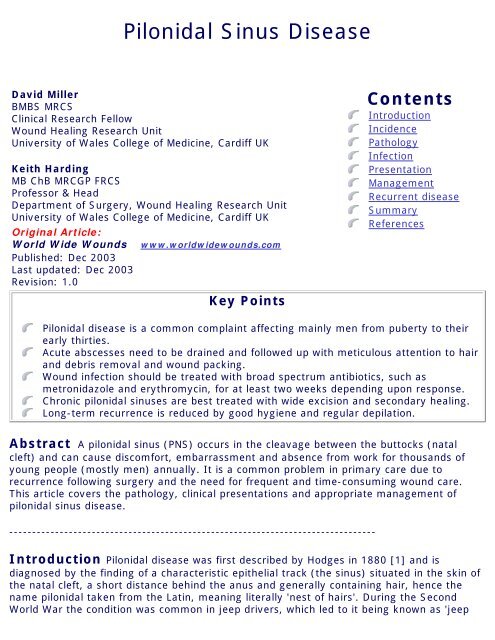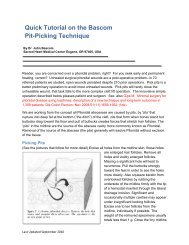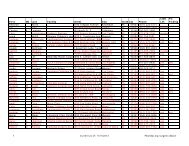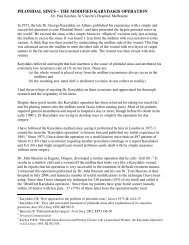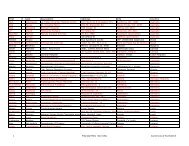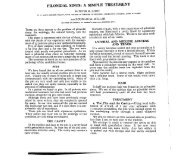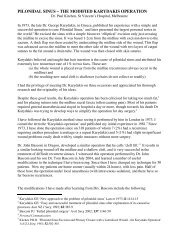Wound Healing Research Unit - Pilonidal Disease
Wound Healing Research Unit - Pilonidal Disease
Wound Healing Research Unit - Pilonidal Disease
You also want an ePaper? Increase the reach of your titles
YUMPU automatically turns print PDFs into web optimized ePapers that Google loves.
<strong>Pilonidal</strong> Sinus <strong>Disease</strong><br />
David Miller<br />
BMBS MRCS<br />
Clinical <strong>Research</strong> Fellow<br />
<strong>Wound</strong> <strong>Healing</strong> <strong>Research</strong> <strong>Unit</strong><br />
University of Wales College of Medicine, Cardiff UK<br />
Keith Harding<br />
MB ChB MRCGP FRCS<br />
Professor & Head<br />
Department of Surgery, <strong>Wound</strong> <strong>Healing</strong> <strong>Research</strong> <strong>Unit</strong><br />
University of Wales College of Medicine, Cardiff UK<br />
Original Article:<br />
World Wide <strong>Wound</strong>s www.worldwidewounds.com<br />
Published: Dec 2003<br />
Last updated: Dec 2003<br />
Revision: 1.0<br />
Key Points<br />
Contents<br />
Introduction<br />
Incidence<br />
Pathology<br />
Infection<br />
Presentation<br />
Management<br />
Recurrent disease<br />
Summary<br />
References<br />
<strong>Pilonidal</strong> disease is a common complaint affecting mainly men from puberty to their<br />
early thirties.<br />
Acute abscesses need to be drained and followed up with meticulous attention to hair<br />
and debris removal and wound packing.<br />
<strong>Wound</strong> infection should be treated with broad spectrum antibiotics, such as<br />
metronidazole and erythromycin, for at least two weeks depending upon response.<br />
Chronic pilonidal sinuses are best treated with wide excision and secondary healing.<br />
Long-term recurrence is reduced by good hygiene and regular depilation.<br />
Abstract A pilonidal sinus (PNS) occurs in the cleavage between the buttocks (natal<br />
cleft) and can cause discomfort, embarrassment and absence from work for thousands of<br />
young people (mostly men) annually. It is a common problem in primary care due to<br />
recurrence following surgery and the need for frequent and time-consuming wound care.<br />
This article covers the pathology, clinical presentations and appropriate management of<br />
pilonidal sinus disease.<br />
--------------------------------------------------------------------------------<br />
Introduction <strong>Pilonidal</strong> disease was first described by Hodges in 1880 [1] and is<br />
diagnosed by the finding of a characteristic epithelial track (the sinus) situated in the skin of<br />
the natal cleft, a short distance behind the anus and generally containing hair, hence the<br />
name pilonidal taken from the Latin, meaning literally 'nest of hairs'. During the Second<br />
World War the condition was common in jeep drivers, which led to it being known as 'jeep
disease'. A similar condition arises in the clefts between the fingers of barbers or<br />
hairdressers caused by customers' hair entering moist, damaged skin.<br />
Incidence The onset of PNS is rare both before puberty and after the age of 40. Males<br />
are affected more frequently than females, probably due to their more hirsute nature [2]. In<br />
a population study of 50,000 students the incidence in males was 1.1%, ten times more<br />
than in females [3], although many of these were asymptomatic. Figures from the Office of<br />
Population Censuses and Surveys (1985) record 7,000 patients as having had inpatient<br />
treatment for PNS in England. Proportionately females make up a quarter of those<br />
undergoing hospital treatments [4], possibly reflecting under-reporting in the male<br />
population. The condition is more common in Caucasians than Asians or Africans due to<br />
differing hair characteristics and growth patterns [5]. In a study of risk factors the following<br />
associations were found [2]:<br />
sedentary occupation 44%<br />
positive family history 38%<br />
obesity 50%<br />
local irritation or trauma prior to onset of symptoms 34%.<br />
Pathology The origin of pilonidal disease is not fully understood, but the majority of<br />
opinion favours the acquired theory, which may be summed up as:<br />
Hormones<br />
Hair<br />
Friction<br />
Infection<br />
Sex hormones first produced at puberty are known to affect the pilosebaceous glands,<br />
which coincides with the earliest onset of pilonidal disease [6]. <strong>Pilonidal</strong> disease is associated<br />
with visible pits in the midline of the natal cleft, which have the microscopic appearance of<br />
enlarged hair follicles[7]. The enlargement is thought to occur due to stretching of the<br />
follicular openings caused by the weight of the buttocks being pulled by gravity[7]. The<br />
magnitude of this force is enhanced by its application over a small area (approximately<br />
1mm²), where the natal cleft curves over the sharp angle at the sacro-coccygeal joint. This<br />
force may be amplified by activities such as bouncing while upright, slumping while seated or<br />
bouncing on a hard seat as in 'jeep disease'. If the force applied reaches a critical level then<br />
the base of the follicle ruptures as this is the weakest part at which the skin is tethered to<br />
the subcutaneous tissue. The same forces, together with friction between the buttocks, are<br />
also responsible for sucking keratin and hair into the distended follicles, which leads to<br />
infection of the follicle and abscess formation.<br />
It had long been believed that hair follicles alone were the source of pilonidal disease[7].<br />
However, more recent work on specimens following wide excision has shown that the pits<br />
penetrating into the dermis were distended with keratin and debris, but not all arose in hair<br />
follicles[8].<br />
Furthermore, hair entry to the follicles by a variety of means was originally thought to be the
primary event in the development of PNS. However, there is evidence to suggest that the<br />
enlargement of the follicles precedes hair gaining access and at operation hair is found in<br />
only half of cases[7]. Hair acts as a foreign body causing an inflammatory reaction and can<br />
lead to prolonged inflammation and the development of chronic pilonidal disease. As such,<br />
the hairs that gave pilonidal disease its name may not be the primary insult but nonetheless<br />
are an important secondary event. The source of hair can be either the natal cleft itself in<br />
hirsute individuals, or hair from the head or back that falls down inside clothes into the natal<br />
cleft. Distension of the obstructed follicle leads to oedema and inflammation resulting in<br />
occlusion of the mouth of the pit, with subsequent infection and abscess formation in the<br />
subcutaneous fatty tissue (the patient may present at this stage). Over time a chronic<br />
abscess develops and it is the formation of the track draining this abscess cavity that is<br />
known as a sinus. The combination of a deep abscess cavity with surrounding moist<br />
conditions and abundant bacteria, hair, debris and friction cause recurrent infection,<br />
associated with chronic pain and discharge.<br />
Malignant change is a relatively rare complication of pilonidal disease[8], but evidence of at<br />
least 50 such cases is available in published medical literature. The most common scenario is<br />
of squamous cell carcinoma arising after decades of antecedent pilonidal disease. Its<br />
pathophysiology is uncertain, but the ongoing processes of tissue damage and repair in the<br />
presence of chronic inflammation may be implicated[9]. Malignancy arising in a chronic<br />
wound seems to have a worse prognosis than cutaneous malignancies arising de novo on the<br />
skin, hence early detection is imperative[9]. Although malignancy is a rare complication, it is<br />
a significant risk to young men and a more sinister reason why, besides discomfort and<br />
inconvenience, pilonidal disease should be taken seriously and sufferers encouraged to seek<br />
medical help.<br />
Infection Anaerobic bacteria (particularly Bacteroides and Enterococci) predominate<br />
over aerobic bacteria (Staphylococci and Haemolytic Streptococci) in the development of<br />
infection of the follicles and abscess formation. Anaerobes are predominantly responsible for<br />
reinfection and subsequent wound breakdown following surgery[10]. However a more<br />
recent prospective study of 49 infected postoperative wounds isolated aerobic bacteria in<br />
43% of cases[11]. Treatment of pilonidal infection should be with broad spectrum<br />
antibiotics.<br />
Presentation A PNS may be asymptomatic for some time prior to presentation. The<br />
majority of patients only present with the onset of symptoms, usually pain and discharge.<br />
Occasionally a painless lump or swelling may be discovered by the patient while washing, or<br />
the characteristic midline pits may be found during a routine physical examination.<br />
Symptomatic disease usually presents[12] as an acute pilonidal abscess, a chronic pilonidal<br />
abscess or complex/recurrent pilonidal disease.<br />
Acute pilonidal abscess The patient notices increasing discomfort and swelling over<br />
a number of days and the pain may be severe by the time of presentation. On<br />
examination there is a localised fluctuant swelling in the midline of the natal cleft with<br />
overlying cellulitis. The area is exquisitely painful to touch and often simply the act of<br />
separating the buttocks to examine the area is intolerable for the patient.
Chronic pilonidal disease It is common for patients to present with chronic pain<br />
and discharge, often with a history of up to two years[2]. On examination a single, or<br />
occasionally, multiple sinuses may be seen. Tufts of hair or other debris, such as<br />
clothing fibres, are often visible arising from the sinus. Localised oedema, swelling<br />
and inflammation may be present masking the underlying sinus.<br />
Complex or recurrent pilonidal disease This is due to reinfection in neighbouring<br />
hair follicles or chronic infection from entry of hair or debris into a postoperative<br />
wound.<br />
Management This will depend upon the nature of presentation and the attitude and<br />
wishes of the individual concerned. Regardless of the treatment selected, the aims remain<br />
similar:<br />
Treatment must be acceptable to the patient in terms of discomfort, impact upon<br />
body image and self-esteem<br />
Rates of complication and recurrence should be minimal<br />
To enable the patient to resume work and normal social activities as early as possible.<br />
The principle management techniques will be discussed below.<br />
Management of asymptomatic PNS For those patients who are truly<br />
asymptomatic, meticulous depilation and local hygiene are advised. It is not known what<br />
proportion of those who are asymptomatic go on to develop symptomatic disease. However,<br />
the risks and discomfort of elective surgery for most of these patients would be<br />
unacceptable and probably outweigh the potential benefit of avoidance of future abscess<br />
formation. Hence surgical intervention in this group is not advised.<br />
Conservative management For the acute abscess that presents early, with pain<br />
that is tolerable and no evidence of cellulitis, broad spectrum antibiotics and depilation<br />
alone may be sufficient to resolve the immediate problem. If symptoms resolve, follow-up<br />
examination for the presence of pits or sinus tracks is recommended along with long-term<br />
depilation and attention to hygiene. The majority of acute cases do, however, require<br />
urgent operative intervention. When pain is severe or cellulitis is present, attempts at<br />
conservative treatment are likely to be futile and will only prolong the patient's discomfort.<br />
Chronic disease can be successfully treated by shaving and meticulous hygiene, but<br />
recurrence rates are unknown[13].<br />
Phenol injection This is a closed technique under local anaesthetic whereby injection<br />
of phenol into a sinus causes sclerosis and gradual closure[14]. The procedure is time<br />
consuming, needs frequent repetition, has a high recurrence rate and has been largely<br />
replaced by operative techniques.<br />
Operative management The number and variety of published techniques are<br />
testament to the complexity of treating PNS and the fact that no single procedure is<br />
superior in all respects. It is universally agreed that the most effective emergency
management of a pilonidal abscess is simple incision and drainage. However, surgical<br />
management of chronic and recurrent disease is more controversial. Numerous studies have<br />
been put forward advocating one treatment over another, but many of these studies are<br />
weighed down by lack of control groups or short follow-up. The majority of procedures can<br />
be classified in one of the four categories below:<br />
Incision and drainage<br />
Excision and healing by secondary intention<br />
Excision and primary closure<br />
Excision with reconstructive flap techniques.<br />
Incision and drainage: This is a simple procedure that involves making an elliptical<br />
incision in the abscess just off the midline. The mouth of the wound should be of sufficient<br />
width to allow packing of the entire wound cavity. Curettage to remove dead or infected<br />
tissue in the wound improves the rate of healing, with 90% completely healed at one<br />
month, compared to just 58% healed at 10 weeks in the absence of curettage[5].<br />
Following a single incision and drainage procedure, 40-60% will go on to develop a PNS<br />
requiring further surgery. Pits or sinuses can be excised as part of an incision and drainage<br />
procedure, but these can be obscured by oedema and are often overlooked at the initial<br />
assessment[7]. The recurrence rate can be reduced to about 15% if a second procedure to<br />
excise pits and sinuses is performed after five to seven days[5].<br />
<strong>Healing</strong> by secondary intention has the advantage of allowing free drainage of infected<br />
material and debris. However the patient will require regular wound care and the discomfort<br />
of packing until the wound has closed. In a retrospective study mean number of days off<br />
work following incision and drainage was 20[15].<br />
Wide excision and healing by secondary intention: Wide excision of an elliptical wedge<br />
of skin and subcutaneous tissue down to the pre-sacral fascia is designed to remove all the<br />
inflamed tissue and debris allowing the wound to granulate from its base. The excised<br />
dimensions should be of sufficient width at both the mouth and base of the wound to allow<br />
packing with ease. The base itself should be relatively flat and of almost comparable size to<br />
the mouth of the wound. A narrow V-shaped wound without a flat base is more difficult to<br />
pack and has a tendency to bridging and subsequent infection. The procedure necessitates<br />
general anaesthesia and hospital stay for a few days postoperatively. The principal<br />
advantage is a low recurrence rate but the downside is a lengthy healing time (8-10<br />
weeks)[16] and high direct and indirect costs associated with inpatient care, follow-up<br />
wound care and days lost from work. Despite this there is a role for wide excision in those<br />
with extensive chronic disease and following failed primary closure surgical technique.<br />
Figures 1a-e show different stages in the healing of chronic disease in a young male treated<br />
by wide excision.
Figure 1a - Wide excision for chronic<br />
pilonidal disease in a young male:<br />
preoperative marking of excision markings<br />
Figure 1b - Two weeks post excision<br />
Figure 1c - Four weeks post excision<br />
Figure 1d - Eight weeks post excision
Figure 1e - Ten weeks post excision<br />
A modification of the standard excision is 'marsupialisation'. The skin edges are not excised,<br />
but are sutured to the sides of the wound. The mean healing time in 125 patients who<br />
underwent this procedure was shown to be four weeks with a recurrence rate of 6%[12].<br />
Excision and primary closure: Closure of the wound is more cosmetically acceptable for<br />
some patients and is associated with a shorter healing time and time off work. However,<br />
this potential benefit is offset by the need for bed rest for up to one week in hospital[17]<br />
coupled with a higher risk of postoperative infection. When infection intervenes the wound<br />
must be laid open and healing time is longer than if the wound had been treated by<br />
secondary intention in the first place. The scar can be sited over the midline or displaced<br />
laterally with one year recurrence rates of 18% and 10% respectively[5]. In a recent<br />
prospective study failure of primary healing was significantly associated with early<br />
recurrence of disease[18]. In the same study the use of preoperative antibiotics did not<br />
influence the recurrence rate.<br />
Bascom has proposed a method to incise, drain and curette a chronic abscess through a<br />
lateral incision combined with excision of any midline pits with a minimal amount of<br />
surrounding tissue[7]. A section of the wall of the abscess cavity opposite the incision is<br />
raised as a flap and used to close the communication between the midline pits and the<br />
abscess cavity. This is accomplished by suturing the flap to the underside of the skin bridge<br />
formed between the incision and the midline. In a recent study of 218 patients treated with<br />
Bascom's procedure as day cases, 6% developed a postoperative abscess requiring<br />
drainage and 10% had recurrence requiring further surgery at mean follow up of 12.1<br />
months (range 1-60 months)[19].<br />
Excision with reconstructive procedures: These procedures are more technically<br />
demanding and are probably best performed by a plastic surgeon. Their use is generally<br />
restricted to recurrent complex pilonidal disease. The theory behind the majority of
procedures is to reshape and flatten the natal cleft to reduce friction, local warmth,<br />
moisture and hair accumulation. Karydakis pioneered a procedure raising a flap to overlap<br />
the midline with the scar sited to one side to reduce postoperative hair entry[20].<br />
Alternative techniques use a flap of both skin and muscle or a Z-plasty flap to close the<br />
defect following excision[17]. All these techniques require general anaesthesia and a week<br />
or more of bed rest in hospital.<br />
Postoperative wound care Following incision and drainage or excision procedures<br />
the wound should be packed with an alginate dressing. Following this the wound can be<br />
managed with foam dressing that forms in situ (eg Cavicare) and an appropriate secondary<br />
dressing. The foam dressing keeps the wound open preventing premature closure of the<br />
wound edges. However, a new stent needs to be made approximately every two weeks to<br />
allow for wound contracture and is contraindicated when there are signs of infection. Hair<br />
and any debris should be removed at every wound inspection and the natal cleft should be<br />
kept hair free by weekly shaving or use of depilatory agents. Depilation is usually<br />
continued until wound healing, although the authors would recommend this practice<br />
continue long term[21] or at least until the patient reaches his late thirties when recurrence<br />
is unlikely.<br />
Early signs of wound infection include increased pain and an abnormal dark 'beefy' red<br />
appearance to the granulation tissue which is friable, bleeds on contact and exhibits<br />
superficial bridging. Prompt treatment with broad spectrum antibiotics such as<br />
metronidazole and erythromycin or clarithromycin is advised for a minimum of two<br />
weeks[10]. The use of dressings containing antiseptics such as iodine (eg Inadine),<br />
although controversial, may have beneficial effects.<br />
Recurrent disease Recurrence can be divided into two groups: early and late. Early<br />
recurrence is usually due to failure to identify one or more sinuses at incision and drainage,<br />
which was not followed by a second-look procedure. Late recurrence is usually due to<br />
secondary infection caused by residual hair or debris that was not removed at operation,<br />
inadequate wound care or insufficient attention to depilation[21].<br />
Summary <strong>Pilonidal</strong> disease is a complex condition that causes both discomfort and<br />
embarrassment to sufferers. Direct costs to the healthcare system and indirect costs<br />
through absence from work are high. Incision and drainage (with curettage) is<br />
recommended for treatment of pilonidal abscesses. Wide excision and healing by secondary<br />
intention is the recommended treatment of most chronic disease. The surgical management<br />
of complex or recurrent disease should be under a surgeon with an interest in pilonidal<br />
disease. Regardless of the surgical technique concerned, standard principles of wound care<br />
are essential with repeated depilation of the natal cleft, removal of hair and any debris from<br />
the wound bed and keeping the wound edges separated using an appropriate dressing.<br />
References<br />
1. Hodges RM. <strong>Pilonidal</strong> sinus. Boston Med Surg J 1880; 103: 485-586.<br />
2. Sondenaa K, Nesvik I, Anderson E, Natas O, Soreide JA. Patient characteristics and
symptoms in chronic pilonidal sinus disease. Int J Colorectal Dis 1995; 10(1): 39-42.<br />
3. Dwight RW, Maloy JK. <strong>Pilonidal</strong> sinus: experience with 449 cases. N Engl J Med 1953;<br />
249: 926-30.<br />
4. Buie LA, Curtis PD. <strong>Pilonidal</strong> disease. Surg Clin NA 1952; 32: 1247-59.<br />
5. Berry DP. <strong>Pilonidal</strong> sinus disease. J <strong>Wound</strong> Care 1992; 1(3): 29-32.<br />
6. Price ML, Griffiths WAD. Normal body hair: a review. Clin Exp Dermatol 1985; 10: 87-97.<br />
7. Bascom JU. <strong>Pilonidal</strong> disease: correcting over treatment and under treatment.<br />
Contemporary Surg 1981; 18: 13-28.<br />
8. Lineaweaver WC, Brunson MB, Smith JF, Franzini DA, Rumley TO. Squamous carcinoma<br />
arising in a pilonidal sinus. J Surg Oncol 1984; 27(4): 39-42.<br />
9. Trent JT, Kirsner RS. <strong>Wound</strong>s and malignancy. Adv Skin <strong>Wound</strong> Care 2003; 16(1): 31-<br />
34.<br />
10. Marks J, Harding KG, Hughes LE, Riberio CD. <strong>Pilonidal</strong> sinus excision: healing by open<br />
granulation. Br J Surg 1985; 72(8): 637-40.<br />
11. Sondenaa K, Nesvik I, Andersen E, et al. Bacteriology and complications of chronic<br />
pilonidal sinus treatment with excision and primary suture. Int J Colorectal Dis 1995; 10(3):<br />
161-66.<br />
12. Solla JA, Rothenberger DA. Chronic pilonidal disease. An assessment of 150 cases. Dis<br />
Col Rec 1990; 33(9): 758-61.<br />
13. Hodgkin W. <strong>Pilonidal</strong> sinus disease. J <strong>Wound</strong> Care 1998; 7(9): 481-83.<br />
14. Stansby G, Greatorex R. Phenol treatment of pilonidal sinus of the natal cleft. Br J Surg<br />
1989; 76(7): 729-30.<br />
15. Bissett IP, Isbister WH. The management of patients with pilonidal disease: a<br />
comparative study. Aust NZ J Surg 1987; 57(12): 939-42.<br />
16. Kronberg I, Christensen KI, Zimmerman-Nielson O. Chronic pilonidal disease: a<br />
randomised trial with complete three year follow up. Br J Surg 1986; 72: 303-04.<br />
17. Jones DJ. ABC of colorectal diseases. <strong>Pilonidal</strong> sinus. BMJ 1992; 305: 410-12.<br />
18. Sondenaa K, Diab R, Nesvik I, et al. Influence of failure of primary wound healing on<br />
subsequent recurrence of pilonidal sinus. Eur J Surg 2002; 168(11): 614-18.<br />
19. Senapati A, Cripps NP, Thompson MR, Franzini DA. Bascom's operation in the day-
surgical management of symptomatic pilonidal sinus. Br J Surg 2000; 87: 1067-70.<br />
20. Karydakis GE. New approach to the problem of pilonidal sinus. Lancet 1973; 2: 1414-<br />
15.<br />
21. Allen-Marsh TG. <strong>Pilonidal</strong> sinus: finding the right track for treatment. Br J Surg 1990;<br />
77: 123-32.<br />
http://www.worldwidewounds.com/2003/december/Miller/<strong>Pilonidal</strong>-Sinus.html


